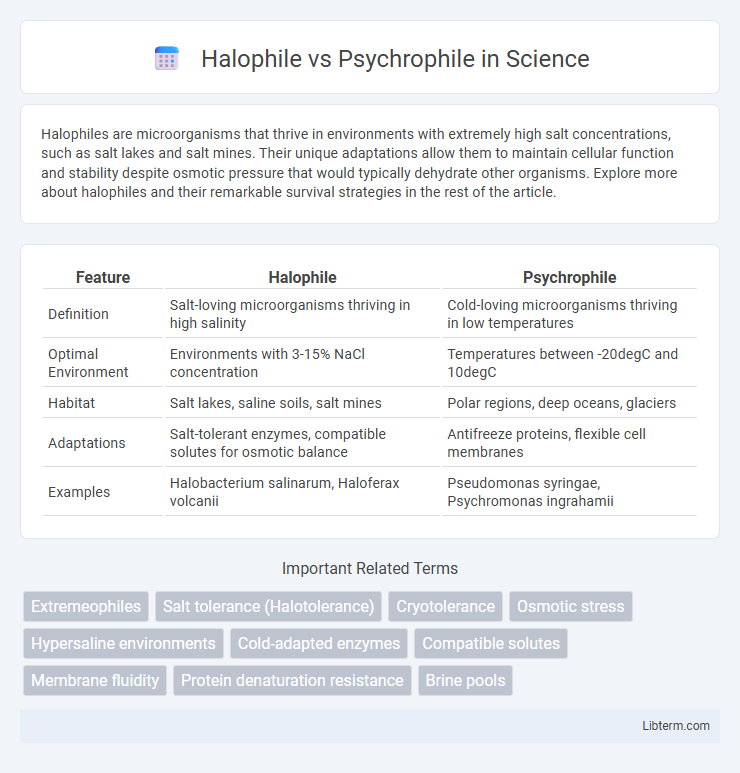Halophiles are microorganisms that thrive in environments with extremely high salt concentrations, such as salt lakes and salt mines. Their unique adaptations allow them to maintain cellular function and stability despite osmotic pressure that would typically dehydrate other organisms. Explore more about halophiles and their remarkable survival strategies in the rest of the article.
Table of Comparison
| Feature | Halophile | Psychrophile |
|---|---|---|
| Definition | Salt-loving microorganisms thriving in high salinity | Cold-loving microorganisms thriving in low temperatures |
| Optimal Environment | Environments with 3-15% NaCl concentration | Temperatures between -20degC and 10degC |
| Habitat | Salt lakes, saline soils, salt mines | Polar regions, deep oceans, glaciers |
| Adaptations | Salt-tolerant enzymes, compatible solutes for osmotic balance | Antifreeze proteins, flexible cell membranes |
| Examples | Halobacterium salinarum, Haloferax volcanii | Pseudomonas syringae, Psychromonas ingrahamii |
Introduction to Extremophiles
Extremophiles are microorganisms that thrive in environments considered hostile to most life forms, such as extreme salinity or temperature conditions. Halophiles specifically adapt to high-salt habitats like salt lakes and saline soils by regulating osmotic pressure through compatible solutes. Psychrophiles inhabit permanently cold environments, such as polar regions and deep ocean waters, producing specialized enzymes and membrane structures to maintain metabolic activity at low temperatures.
Defining Halophiles: Salt-Loving Microbes
Halophiles are salt-loving microbes that thrive in environments with high salinity, such as salt flats, saline lakes, and salted foods, exhibiting specialized adaptations to maintain cellular function under osmotic stress. These extremophiles use compatible solutes or ion pumps to balance osmotic pressure and stabilize proteins and membranes in hypertonic conditions. In contrast, psychrophiles are cold-adapted organisms optimized for growth at temperatures below 15degC, relying on fluid membranes and cold-active enzymes rather than salt tolerance mechanisms.
Psychrophiles: Thriving in the Cold
Psychrophiles are microorganisms adapted to thrive in extremely cold environments, such as polar regions and high-altitude ecosystems, by maintaining enzyme functionality and membrane fluidity at low temperatures. These cold-loving microbes exhibit optimal growth below 15degC, with some capable of growth at subzero temperatures, relying on specialized antifreeze proteins and cryoprotectants to prevent ice crystal formation. In contrast, halophiles thrive in high-salinity conditions, demonstrating the diversity of extremophiles adapted to distinct environmental stresses.
Key Environmental Differences: Salinity vs. Temperature
Halophiles thrive in high-salinity environments, such as salt lakes or saline soils, where salt concentrations often exceed 20%, requiring specialized cellular mechanisms to maintain osmotic balance. Psychrophiles are adapted to extremely low temperatures, commonly found in polar regions and deep ocean waters, where temperatures can drop below freezing, necessitating membrane fluidity and enzyme function adaptations. The core environmental difference lies in halophiles' adaptation to hypersaline conditions versus psychrophiles' survival in consistently cold habitats.
Cellular Adaptations in Halophiles
Halophiles exhibit cellular adaptations such as specialized ion pumps and compatible solute accumulation to maintain osmotic balance in high-salt environments. Their proteins and enzymes have evolved increased surface acidity to remain stable and functional under hypersaline conditions. These traits contrast with psychrophiles, which adapt to cold by producing antifreeze proteins and maintaining membrane fluidity.
Survival Mechanisms of Psychrophiles
Psychrophiles survive in extreme cold environments through specialized adaptations such as producing antifreeze proteins that prevent ice crystal formation in their cells and maintaining membrane fluidity by incorporating unsaturated fatty acids. Their enzymes are structurally adapted to function efficiently at low temperatures, enabling metabolic processes to continue despite the cold. These survival mechanisms distinguish psychrophiles from halophiles, which are adapted to high-salt environments through osmoprotectant accumulation and salt-tolerant enzyme systems.
Ecological Niches: Where Halophiles and Psychrophiles Live
Halophiles thrive in high-salinity environments such as salt lakes, saline soils, and salt evaporation ponds, where salt concentrations exceed 3%. Psychrophiles inhabit consistently cold ecosystems like polar ice, deep ocean waters, and alpine glaciers, adapting to temperatures below 15degC. These distinctive ecological niches highlight the adaptation of halophiles to osmotic stress and psychrophiles to cold stress, enabling survival in extreme habitats.
Industrial and Biotechnological Applications
Halophiles, thriving in high-salt environments, produce salt-tolerant enzymes and biopolymers utilized in bioremediation, food processing, and pharmaceutical industries due to their stability under extreme salinity. Psychrophiles adapt to cold environments by synthesizing cold-active enzymes and antifreeze proteins, enhancing applications in biocatalysis at low temperatures, cold washing detergents, and food preservation. Both extremophile groups contribute to sustainable industrial processes by enabling biochemical reactions under extreme conditions with reduced energy consumption.
Challenges in Studying Halophiles and Psychrophiles
Studying halophiles presents challenges due to their requirement for extreme salt concentrations, which can interfere with standard laboratory equipment and culture media stability. Psychrophiles require consistently low temperatures for growth, making it difficult to maintain appropriate environmental conditions for long-term experiments and biochemical assays. Both microorganisms often exhibit slow growth rates and unique metabolic pathways, complicating isolation, cultivation, and genomic analysis.
Future Directions in Extremophile Research
Future directions in extremophile research emphasize genomic and proteomic analyses to uncover adaptive mechanisms in halophiles and psychrophiles, enabling biotechnological applications such as enzyme development for high-salt and low-temperature industrial processes. Advancements in synthetic biology and metagenomics are expected to facilitate the engineering of extremophilic traits into conventional organisms, expanding possibilities for bioremediation and sustainable biosynthesis. Research into extremophile resilience under climate change conditions will also be critical for understanding their ecological roles and potential for novel biomolecules.
Halophile Infographic

 libterm.com
libterm.com